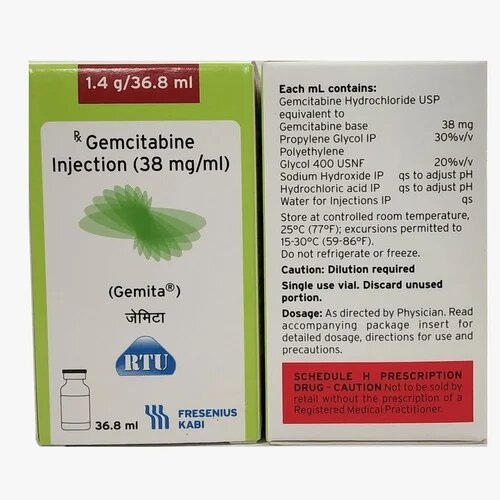Product Intro:
Gemita is a sterile, preservative-free lyophilized powder for intravenous injection. It contains Gemcitabine hydrochloride, a nucleoside analog that disrupts DNA synthesis. It is primarily indicated for various carcinomas and is usually administered in combination with other chemotherapeutic agents.
Uses (Indications):
-
Non-Small Cell Lung Cancer (NSCLC):
-
Pancreatic Cancer:
-
Breast Cancer:
-
Ovarian Cancer:
-
Bladder Cancer:
-
Off-Label Uses:
Storage Instructions:
-
Store unreconstituted vials at 20–25 °C (68–77 °F) in a dry area.
-
Protect from light and excessive moisture.
-
Once reconstituted, use within 24 hours if stored at 2–8 °C.
-
Discard unused solution after the recommended period.
How It Works (Mechanism of Action):
Gemcitabine is a pyrimidine antimetabolite structurally similar to cytarabine. It undergoes intracellular phosphorylation to its active diphosphate and triphosphate forms. These metabolites:
-
Inhibit DNA polymerase and ribonucleotide reductase, enzymes essential for DNA replication.
-
Incorporate into DNA strands, leading to chain termination and apoptosis of cancer cells.
Because it preferentially targets dividing cells, it selectively affects rapidly proliferating tumor cells more than normal cells.
Side Effects:
Common Side Effects:
-
Bone marrow suppression: Neutropenia, anemia, and thrombocytopenia
-
Flu-like symptoms: Fever, chills, myalgia
-
Nausea, vomiting, and diarrhea
-
Fatigue and weakness
-
Elevated liver enzymes (AST, ALT)
-
Skin rash and hair thinning
Severe or Rare Side Effects:
-
Pulmonary toxicity: Interstitial pneumonitis, pulmonary edema
-
Hemolytic-uremic syndrome (HUS): A potentially fatal condition
-
Thrombotic thrombocytopenic purpura (TTP): Rare but serious
-
Severe hepatotoxicity or renal impairment
-
Cardiac events: Arrhythmias, myocardial infarction (rare)
-
Anaphylaxis or hypersensitivity reactions
Dosage (Typical Recommended Dose):
Dosage depends on the cancer type, regimen, and patient’s body surface area (BSA).
-
NSCLC (with cisplatin):
-
Gemcitabine 1000 mg/m² IV on Days 1, 8, and 15 of a 28-day cycle
-
Pancreatic Cancer:
-
1000 mg/m² IV once weekly for 7 weeks followed by a 1-week rest period, then weekly for 3 of every 4 weeks
-
Breast Cancer (with paclitaxel):
-
1250 mg/m² on Days 1 and 8 every 21 days
-
Ovarian Cancer:
-
1000 mg/m² on Days 1 and 8 of a 21-day cycle with carboplatin
-
Bladder Cancer:
-
1000 mg/m² on Days 1, 8, and 15 with cisplatin every 28 days
Dose adjustments are required for myelosuppression, hepatic, or renal dysfunction.
Method of Administration:
-
Administer via intravenous infusion only.
-
Reconstitute with 0.9% sodium chloride injection (without preservatives).
-
Infuse over 30 minutes. Longer infusions may increase toxicity.
-
Use sterile technique and avoid shaking the vial vigorously.
-
Do not administer as an IV bolus.
Precautions:
-
Monitor complete blood count (CBC) regularly, especially WBCs and platelets.
-
Assess liver and kidney function before and during treatment.
-
Caution in elderly or debilitated patients.
-
Avoid recent or concurrent radiation therapy unless medically supervised.
-
Pregnancy Category D: Not safe for use in pregnancy or breastfeeding.
-
Hydration is important to reduce renal toxicity risk.
-
Avoid live vaccines during treatment.
Drug Interactions:
-
Platinum compounds (e.g., cisplatin): Increased myelosuppression—monitor blood counts closely.
-
Fluorouracil (5-FU): May increase toxicity when used concurrently.
-
Live vaccines: Risk of serious infections—avoid during and after therapy.
-
Radiation therapy: Concurrent use increases risk of pneumonitis and tissue injury.
-
Other bone marrow suppressants: Additive toxicity.
Allergies (Warnings for Allergic Reactions):
-
Hypersensitivity to Gemcitabine or any excipients is contraindicated.
-
Signs of allergic reaction include: Rash, itching, swelling, dizziness, or shortness of breath.
-
Severe cases: Anaphylaxis or angioedema may require emergency care and drug discontinuation.
Overdose Information:
-
Symptoms: Severe myelosuppression, mucositis, liver enzyme elevation, renal failure
-
No specific antidote exists.
-
Supportive treatment includes:
-
Blood transfusions
-
IV fluids
-
Hemodialysis (if renal failure occurs)
-
Hospitalization may be required for close monitoring and symptomatic management.
Missed Dose Instructions:
-
Inform your healthcare provider immediately.
-
Do not attempt to administer at home.
-
Your oncologist will reschedule the dose based on lab values and toxicity profile.
-
Do not take a double dose.
Additional Notes:
-
Regular monitoring of blood counts is critical for patient safety.
-
Supportive medications (antiemetics, growth factors) may be used to manage side effects.
-
Report respiratory symptoms early, as pulmonary toxicity can be fatal if left untreated.
-
Maintain good hydration to protect kidney function.
-
Infusions should only be performed by trained medical professionals.
-
Fertility may be affected. Discuss options for sperm or egg preservation before starting therapy if needed.



